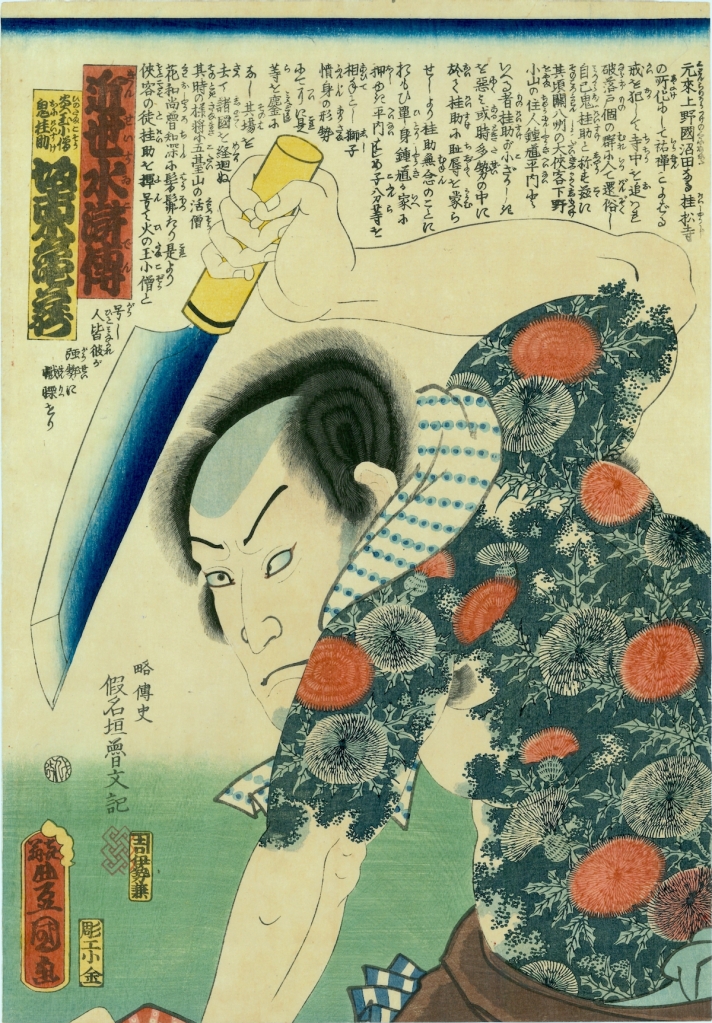The completely fantastical tattoo subject above is a woodblock print by the Japanese ukiyo-e artist Kunisada from 1862. It is a complex design, and a tremendous and highly original tattoo! The print is part of a small selection of prints at the Toshidama Gallery for December 2023. Among the prints are this Kunisada, a fine print by Kunichika of an actor as an Edo fireman, and a stunning Kunisada of the great kabuki anti-hero Danshichi. (below).
What they all have in common is criminality… Danshichi and the bandit, Hinotama Kozô Oni Keisuke in the top picture were both murderers in real life and their spine chilling crimes were very popular in kabuki dramas. All these pictures are actor pictures… famous stage actors portrayed in these roles. Of course the tattoo nowadays is far from a signifier of criminality and has passed into the fashions and commerce of daily life pretty much anywhere… apart from in Japan! There, tattoos were extremely popular among the rougher townspeople of the late Edo period. Later tattoos were regarded as a barbaric relic of the past and forbidden. This ban lasted until 1948 when tattooing was again legalised.
I think that in the west today, the tattoo still carries a slight taboo… the sense of rebellion and certainly the expression of originality and non-conformity in the wearer. We live in a highly conformist and regulated culture. It is depressingly difficult for people to step outside the normal intercourse of daily domestic and working life… ironically in spite of the popular notion that our culture is more tolerant, more accepting of gender, cultural and personal differences. For every encouragement to rebel INTO popular culture and away from societal expectations there is the expectation to conform to a more or less antiseptic and strangulating society where banks, lenders, employers, credit reference agencies, social media and any number of other restraints, drain the living spirit out of us all…
The Surprising Revival of Adolf Loos
…which oddly, leads me away from Japan in the nineteenth century to Germany after the first world war and the career of a strange but influential architect: Adolf Loos. When I was a student in the 1970’s at British art colleges, Loos was an ironic figure to lampoon and deride. He was a modernist, but most famous for his peculiar journalism and often eccentric thoughts on headgear, footwear, furniture and tattoos. In his 1908 essay, Ornament and Crime, he makes the observation that:
There are prisons in which 80% of the inmates have tattoos. The tattoed people who are not in jail are latent-criminals or degenerate aristocrats.
He goes on to emphasise that good design, cultured living and sensible, ordered utility should be devoid of ornament, which he attributes to inferior taste and a lack of culture and civilisation. The essay contains very offensive observations about non-germanic and ethnic societies as well as using the tattoo as an example of the criminality of the tattooed. Although Loos advocated hygeine, utility, cleanliness and decency in all things, his own life was a pitiful catalogue of unsuitable marriages, sexual obsession and finally, prosecution for possession of hundreds of images of child pornography and sexual exploitation of minors. Had he lived, he would undoubtedly have been an enthusiastic Nazi to boot! I was therefore surprised to see that Penguin Random House had repinted Loos’ complete works including Ornament & Crime, as recently as 2019.
I have written on this blog about the development of the tattoo in Japan, its association with heroes and bandits and its popularisation in the 1820’s through Kuniyoshi’s fabulous series of prints, 108 Heroes of the Suikoden. The mainly passive but vast population of townspeople had an uneasy fascination with anti-heroes… much like western cultures today in some ways. There was a particular type of Edo street fighter or gangster called an otokodate, it was imagined that these men were romantic figures who, like the firemen of Edo looked after the poor and downtrodden by opposing the ruling samurai class. These gangs gave way eventually to the organised crime gangs of modern day Tokyo, the Yakuza. The truth was less romantic. The street gangs of Edo were nasty and tough and life around them was highly unpleasant, and yet the full body or the sleeve tattoo that they favoured has persisted outside their culture in defiance firstly of legal prohibition, then of widespread condemnation through commentators such as Adolf Loos, until we arrive today at a place where the extraordinary imagery of ukiyo-e woodblock prints has found its way into the high streets and tattoo shops of every town in England and surely over Europe and America.
Tattoos today continue to represent individuality, personal romantic or cultural preference and to some extent as raised here earlier, a rebellion… beneath the shirt cuffs, against a harsh and authoritarian world.





